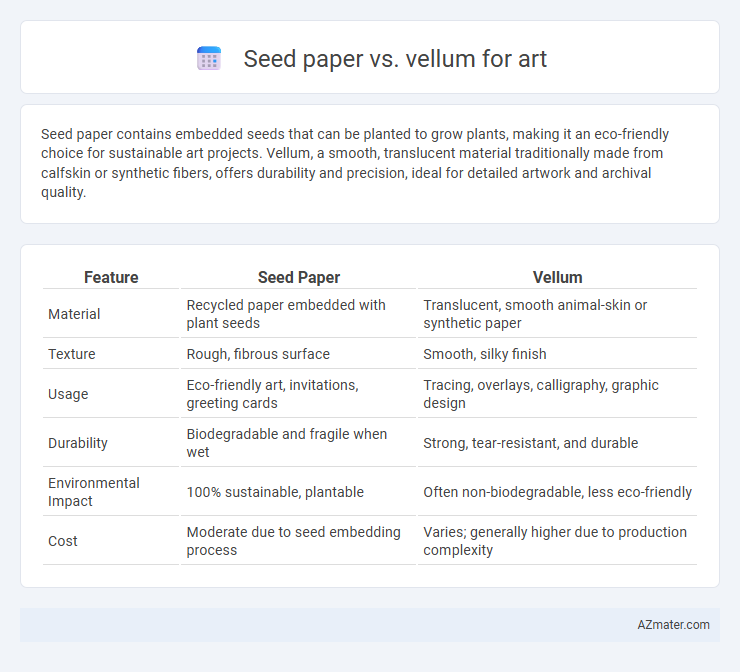Seed paper contains embedded seeds that can be planted to grow plants, making it an eco-friendly choice for sustainable art projects. Vellum, a smooth, translucent material traditionally made from calfskin or synthetic fibers, offers durability and precision, ideal for detailed artwork and archival quality.
Table of Comparison
| Feature | Seed Paper | Vellum |
|---|---|---|
| Material | Recycled paper embedded with plant seeds | Translucent, smooth animal-skin or synthetic paper |
| Texture | Rough, fibrous surface | Smooth, silky finish |
| Usage | Eco-friendly art, invitations, greeting cards | Tracing, overlays, calligraphy, graphic design |
| Durability | Biodegradable and fragile when wet | Strong, tear-resistant, and durable |
| Environmental Impact | 100% sustainable, plantable | Often non-biodegradable, less eco-friendly |
| Cost | Moderate due to seed embedding process | Varies; generally higher due to production complexity |
Introduction to Seed Paper and Vellum
Seed paper is an eco-friendly medium embedded with seeds that germinate when planted, making it popular for sustainable art projects and botanical invitations. Vellum, a translucent, smooth parchment made from calfskin or synthetic materials, offers a unique surface preferred for detailed drawings, calligraphy, and layering effects in fine art. Both seed paper and vellum provide distinct tactile experiences and aesthetic qualities that cater to different artistic techniques and environmental values.
Material Composition and Origins
Seed paper is crafted from recycled fibers embedded with viable seeds, allowing it to be planted and grow wildflowers or herbs, offering a sustainable and eco-friendly medium for art that emphasizes natural regeneration. Vellum, traditionally made from calfskin or synthetic substances mimicking this texture, provides a smooth, durable surface prized for detailed illustrations and calligraphy, tracing its origins back to medieval manuscript production. The choice between seed paper and vellum hinges on material composition--organic seed-infused fibers versus animal-based or synthetic translucent sheets--and the desired artistic and environmental impact.
Texture and Surface Qualities
Seed paper offers a rough, fibrous texture that enhances tactile engagement and creates a natural, organic surface ideal for eco-friendly art projects. Vellum features a smooth, translucent surface that allows artists to achieve precise, detailed work with excellent color vibrancy and layering effects. The choice between seed paper and vellum significantly influences the visual and textural outcome of artworks, with seed paper providing a rustic feel and vellum delivering a sleek, polished finish.
Compatibility with Art Mediums
Seed paper offers a textured surface that works well with watercolor, ink, and pencil, promoting vibrant color absorption and natural blending. Vellum's smooth, translucent finish excels in handling fine ink lines, markers, and airbrushing, providing sharp detail and minimal bleed. Artists seeking versatility in mediums may prefer seed paper for mixed media projects, while vellum suits precision work and layering techniques.
Environmental Impact and Sustainability
Seed paper is an eco-friendly choice for art projects, composed of biodegradable materials embedded with seeds that can be planted, promoting sustainability by reducing waste and supporting plant growth. Vellum, traditionally made from animal hides or synthetic materials, often entails higher environmental costs due to resource-intensive production and limited biodegradability. Artists seeking sustainable materials favor seed paper for its minimal carbon footprint and contribution to green initiatives, contrasting with vellum's less favorable environmental impact.
Durability and Preservation
Seed paper, embedded with plant seeds, offers eco-friendly qualities but lacks the durability and archival properties needed for long-term art preservation, often degrading faster with exposure to moisture and handling. Vellum, made from animal skin or high-quality synthetic materials, provides exceptional durability, resistance to environmental factors, and superior preservation of fine art details over time. Artists prioritizing longevity and heritage value typically prefer vellum for its ability to maintain structural integrity and vibrant imagery through decades or centuries.
Printability and Customization Options
Seed paper offers excellent printability for eco-friendly art projects, providing vibrant color absorption and a natural textured background that enhances organic designs. Vellum features smooth, translucent surfaces ideal for intricate, high-resolution prints and detailed customization such as embossing or foil stamping. Both materials support versatile artistic expressions, but seed paper stands out for sustainable art prints while vellum excels in precision and refined finishes.
Cost Comparison and Accessibility
Seed paper typically costs more than vellum due to its unique biodegradable properties and embedded seeds that enable planting, appealing to eco-conscious artists. Vellum is generally more affordable and widely available, offering a smooth, translucent surface favored for detailed drawing and tracing work. Artists seeking sustainable materials may accept the higher price of seed paper, while those prioritizing budget and ease of procurement often prefer vellum.
Ideal Artistic Applications
Seed paper offers a unique, eco-friendly medium ideal for botanical-themed art, invitations, and environmentally conscious projects, as it can be planted to grow flowers or herbs. Vellum provides a smooth, translucent surface perfect for detailed ink work, calligraphy, and layered art, enhancing depth and precision in drawings. Artists seeking sustainability and texture favor seed paper, while those prioritizing clarity and fine detail prefer vellum for intricate designs.
Choosing the Best Paper for Your Art
Seed paper offers eco-friendly attributes with biodegradable qualities that encourage plant growth, making it ideal for sustainable art projects or eco-conscious artists. Vellum provides a smooth, translucent surface favored for detailed drawings, technical illustrations, and mixed-media art due to its durability and clarity. Choosing the best paper depends on whether you prioritize environmental impact and texture or require precision and transparency in your artwork.

Infographic: Seed paper vs Vellum for Art
 azmater.com
azmater.com